Montero Sport 2023 specs ✅ 2023
Kinh Nghiệm về Montero Sport 2023 specs 2022
Hoàng Quang Hưng đang tìm kiếm từ khóa Montero Sport 2023 specs được Cập Nhật vào lúc : 2022-11-11 17:20:12 . Với phương châm chia sẻ Bí quyết Hướng dẫn trong nội dung bài viết một cách Chi Tiết 2022. Nếu sau khi Read Post vẫn ko hiểu thì hoàn toàn có thể lại Comment ở cuối bài để Admin lý giải và hướng dẫn lại nha.How much should you put down on a new car?
When you intend to buy a car on Philkotse’s website or other new car listing pages, besides the amount you need to pay, the cost of using a car is also a question that many people are interested in. What are the costs incurred during use? How much should you put down on a new car? This is not an easy problem to solve and needs to be calculated in advance before deciding to pay the down payment.
Nội dung chính Show- How much should you put down on a new car?What is a
down payment?Benefits of down paymentHow much should you put down on a new car?Things we likeNot so muchPricing and featuresEquipment listComfort and spaceOn the Road2023 Tập đoàn Mitsubishi Pajero Sport GLS 4x2 specificationsThings we likeNot so muchIs Montero Sport fast?How many horsepower does a Montero Sport have?Is Montero good for offDoes Montero Sport have Turbo?
What is a down payment?
A down payment is an amount that a buyer must pay in the early stages of purchasing a high-priced goods or service such as houses or for sale cars Philippines. An upfront payment represents a portion of the total purchase price, and the buyer will typically have to pay the remainder over months or even years.
Depending on the lender and the type of purchase, the
lender may require a down payment as low as 0% or as high as 50%.
Benefits of down payment
- Help you get the car you love right away even though your savings are not enough to buy it.The procedure for a down payment is very simple and easy: You just need to bring your ID card, household registration, ...Just spend a down payment to immediately own a great value item without having to wait to save enough money or have to borrow from
relatives.
Down payment purchases help consumers reduce the financial burden of having to pay various living expenses. Dividing large sums of money into smaller pieces and paying them one a time will keep you from feeling the loss all once. This is a very suitable option for people with low income.
How much should you put down on a new car?
If you want a down payment for a new car, you need to try to cover least 20% of the purchase car prices Philippines. For a used car in the Philippines, you can pay 10% in advance. If you do not have enough down payment, try to save to reduce the financial burden when buying a car.
Conclusion
Down payment is a form of payment when
buying a car with many benefits. However, you need to buy cars in reputable places or ther new car listing pages to avoid risks. Philkotse is a genuine distributor of used and new cars with a variety of models for you to choose from. Besides improving product quality, Philkotse also constantly improves service quality. In particular, Philkotse offers many special incentives and benefits for customers who put down payment on a car early.
Noticeably in the front is a blacked out grille, headlamp extensions and bumper garnish. On top is a black roof rail and spoiler. The white diamond color option comes with a black roof, which provides a 2-tone design. To complete the all-black concept are the rear bumper garnish and 18-inch alloy wheels.
“Black symbolizes power, elegance and sophistication. With the addition of the Montero Sport in our Black Series collection, we wish to appeal to a market that intends to project the same characteristics the same time give them an SUV that is built to handle anything,” says Mr. Takeshi Hara, President and CEO of MMPC.
The said variant comes in two colors, the other being Jet Black Mica. It also carries the top winning features that made the Montero Sport one of the best-selling SUVs in the country:
· 2.4-liter turbo diesel engine that produces impressive power, torque and fuel efficiency
· Spacious interior with flexible 2nd and 3rd row seats which can be configured to accommodate various cargo loads
· Active and passive safety features that provide a worry-không lấy phí drive:
o Ultrasonic Misacceleration Mitigation System (UMS)
o Forward Collision Mitigation System (FCM)
o Adaptive Cruise Control (ACC)
o Active Stability And Traction Control (ASTC)
· Abundant comfort features and premium interior materials
· HVAC system equipped with nanoe™ air-purifying system.
nanoe™ is a nano-sized particulate ion which helps deodorize and lessen theinhibition of bacteriaand allergens inside the vehicle.
Retail price is PHP 1,981,000 with an additional PHP 15,000 for the White Diamond. To know more about the Montero Sport Black Series, you may schedule an appointment with your preferred dealer.
7.0
Safety, value and features
Things we like
- Value pricingConditional 10-year warrantyAffordable service schedule
Not so much
- Dull steeringEngine noiseExcessive body toàn thân lean through corners
Can a ‘4x4’ SUV present a compelling case for ownership when only two of its four wheels are actually driven? That’s the question posed by the Tập đoàn Mitsubishi Pajero Sport, along with other rivals in this segment like the Isuzu MU-X and Ford Everest. All offer cheaper versions of their rugged, off-road-capable, separate-chassis SUVs that ditch often complex four-wheel drive systems in favour of simpler, cheaper rear-drive layouts.
And it seems ample buyers are responding with an emphatic ‘yes’.
But it does raise a bunch of questions and demand that you properly consider your real-world usage before making what is, the guts of it, a budget-led decision on a likely long-term purchase.
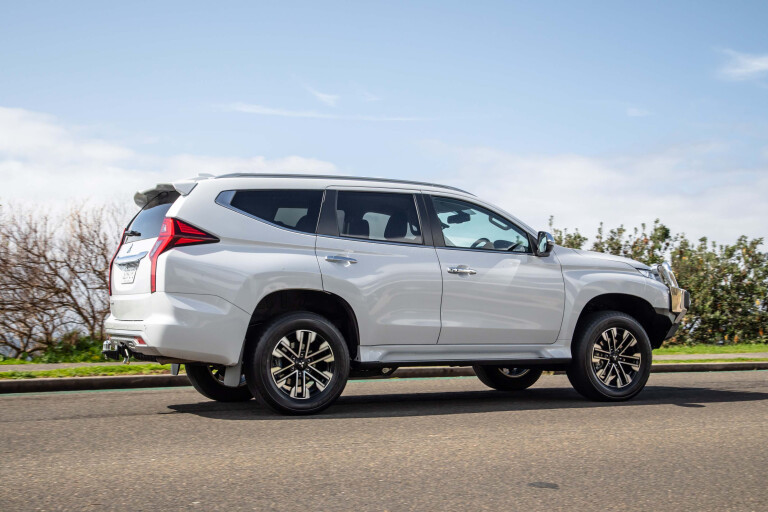
After all, the Pajero Sport, which shares its engine, transmission and much of its platform with the Triton ute, has been engineered from the outset to be capable off-road. Its ground clearance, approach and departure angles and tyre choice are all intended to enable it to tackle terrain too gnarly for most ‘unibody’ SUVs. Obviously, this compromises on-road performance.
But what if your driving ambitions don’t involve dirty weekends deep in the scrub or conquering inland Australia’s toughest tracks?
This third-gen Pajero Sport was first launched in 2015, and while it’s been updated, most recently in 2022, we want to know if it still stacks up when driving the rear rubber only. Or does losing the four-wheel drive system simply miss the point?
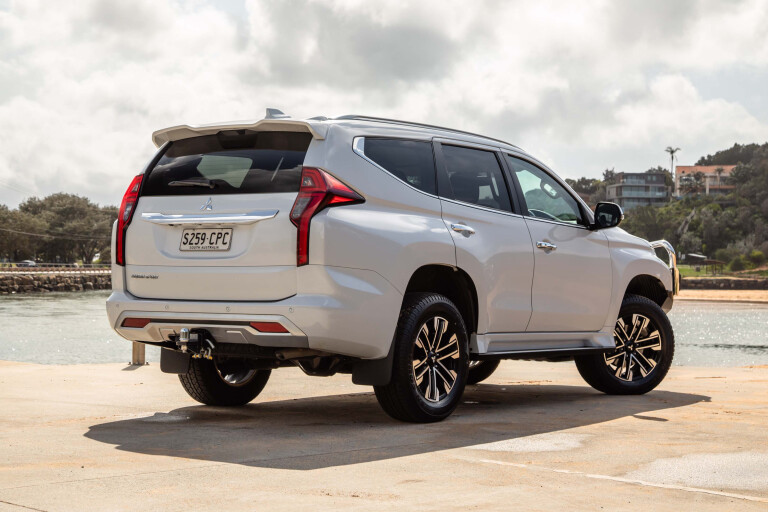
Pricing and features
Our seven-seater Pajero Sport GLS 4×2 on test here retails for $48,690 before on-road costs, which represents a saving of $5000 over the four-wheel drive equivalent, the GLS 4×4.
Competitors in this segment also offering rear-drive include the just-released Ford Everest Ambiente $52,990 and the Isuzu MU-X LS-M, priced $48,900 (both before on-road costs).
A Toyota Fortuner in GX spec is priced into this mix $49,715 plus on-road costs, although it’s four-wheel drive.
The SsangYong Rexton (also four-wheel-drive only) trumps all of these for standard equipment and is keenly priced from $48K drive-away. That’s life as a challenger brand for you.
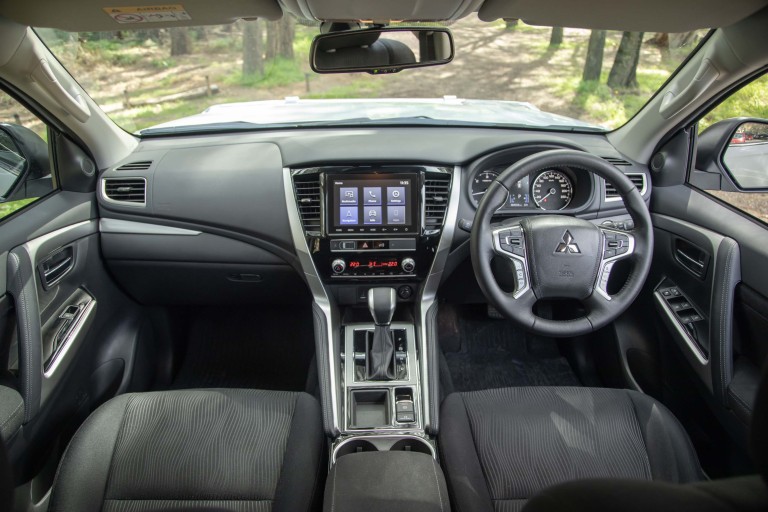
In GLS spec as tested here, the Pajero Sport includes automatic wipers, dual-zone climate control, integrated satellite navigation, DAB+ digital radio, a power tailgate, leather steering wheel, electric parking brake, rear privacy glass, auto-dimming rearview mirror, keyless entry with push-button start, auto-folding mirrors, 18-inch wheels, a 220V power outlet in the middle row and LED front foglights.
For more premium upholstery, a digital instrument display, electrically adjustable heated front seats and a more comprehensive safety suite (which we’ll get to) among other gear, you need to step up to the Pajero Sport Exceed $59,190 before on-road costs, but it’s not offered as a rear-driver.
White is the only no-cost colour; all other colours add $740 with the exception of White Diamond, which is a $940 option.
Our test vehicle also included a Tập đoàn Mitsubishi genuine accessory bull bar, priced a hefty $3879.
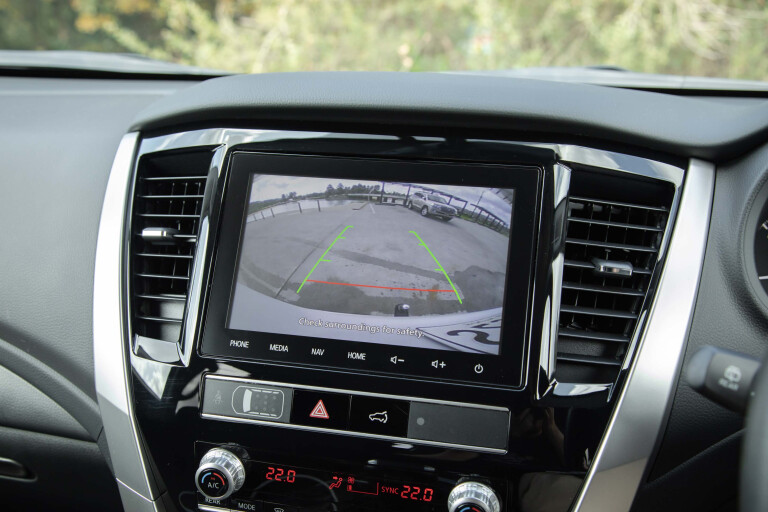
Equipment list
Wired Apple CarPlay and Android Auto DAB+ digital radio Six-speaker sound system Adaptive cruise control Keyless entry and start Leather-wrapped steering wheel and gear selector LED headlights, fog lights and daytime running lights Dual-zone climate control Power-folding exterior mirrors Four-speaker sound system Automatic headlights Rain-sensing wipers Rear privacy glass Power tailgate Electronic parking brake Seven seats
Comfort and space
If you feel that the interiors of current cars have become too ‘screen heavy’ and bafflingly complex, where an algebraic equation is easier than adjusting the air vents, chances are you’ll find the cabin of the Pajero Sport a welcome, uncomplicated respite.
There will be no requirement for a 15-year-old to walk you through the operation of anything in here. The centre console presents a clean, uncluttered layout with simple ventilation controls and an 8.0-inch multimedia screen controlled by straightforward icons in a logical menu structure.
It’s not especially bright or high resolution, nor is it as swift to respond to the touch as some rivals, and the graphics look dated. But least it doesn’t bury commonly used functions under multiple submenus. There’s inbuilt navigation as well as Apple CarPlay and Android Auto via cable connection.

Our main gripe is the lack of a volume knob for the average but acceptable six-speaker audio. There are knobs provided below for the climate control so it’s clear the interior design team wasn't totally allergic to anything that’s not a touch panel. So why relegate the most commonly used function to the most fiddly control possible?
Granted, the driver has the convenience of a volume rocker switch on the steering wheel so it’s more likely to be an inconvenience to the passenger, but it’s a case of dumb design where elsewhere there seems to be an emphasis on logic and simplicity.
We also found the lack of a mute control either on the wheel or the fascia an annoyance, while the voice command button on the steering wheel has zero understanding of anything it’s asked.
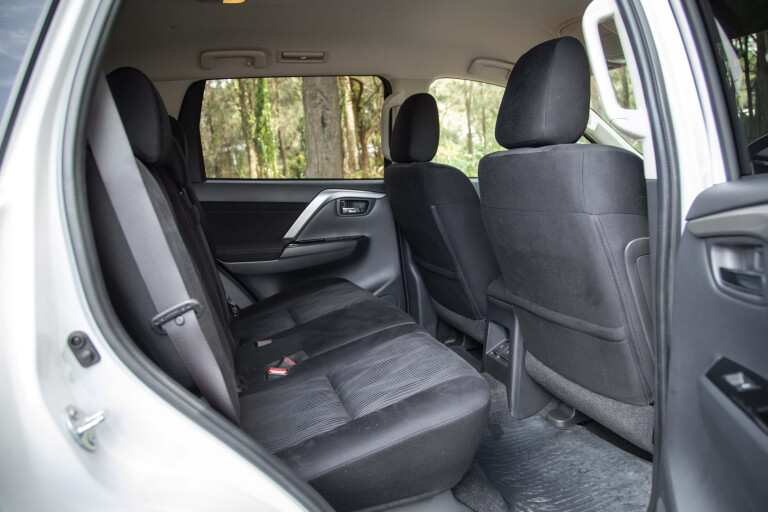
Lack of a digital speedo is also a demerit, although thankfully the analogue dials are crisply legible and sensibly graduated.
Hard plastics are used throughout the cabin, though the use of faux leather trim on areas like the centre console does up perceived material quality slightly.
Both front seats are manually adjusted, with the driver’s providing only adjustment for the base angle (not overall seat height). The driver also gets electric lumbar support. Overall bolstering is okay, the seat doesn’t attempt to grip you too tightly because there’s probably no real need to.
The only shortcoming from my point of view in accommodating my 182cm frame is that the seat base is a bit short to provide optimum under-thigh support. The pedal box, too, is a little more snug than some competitors so longer-limbed drivers may find their legs splayed out to the centre console and door trim.
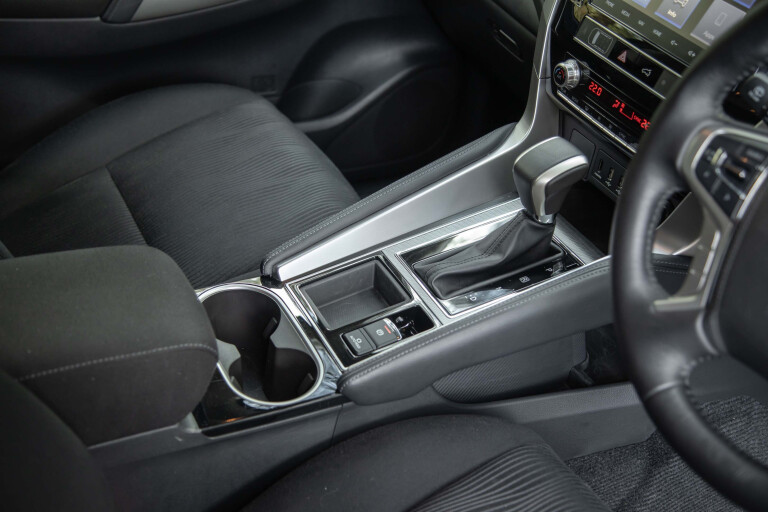
The steering wheel is adjustable for reach and height, but that reach adjustment is limited to 50mm. I would’ve preferred to have been able to pull the wheel a little closer, but no dealbreaker. Less great are the bulky A-pillars, which can obscure important stuff like pedestrians, but the Mitsu is hardly on its own here.
Interior storage space for an SUV in this segment ranks only as adequate. The centre console bin is modestly sized and access into it is blocked by a removable top tray. There is, however, storage on a shelf tucked underneath the centre console.
Door bins are a useful size and accommodate one-litre drink bottles. There’s also a sunglasses compartment in the ceiling but overall, no real surprise nor delight in terms of thoughtful touches or thinking outside of a very conservative box.
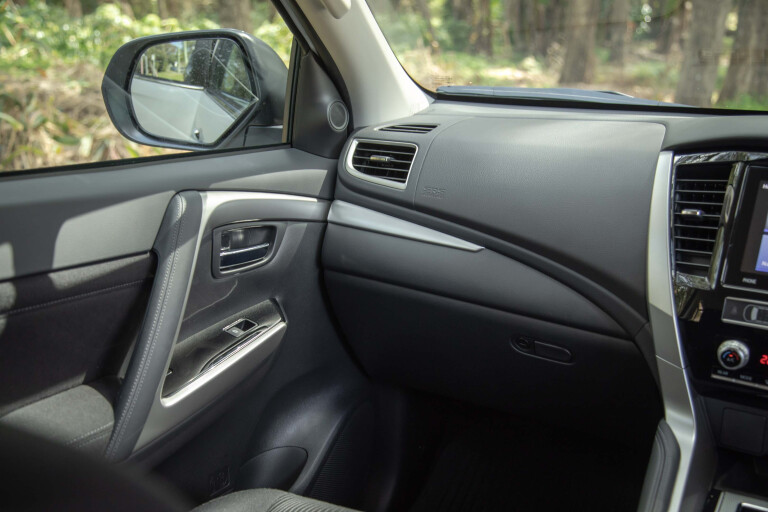
Life in the second row is fine for kids, but tall adults may find the seat base is set a little low, requiring more bending of the legs than most people would prefer. There are two USB sockets, a 220-volt outlet and air vents.
The rear door bins accommodate a standard drink bottle and there are pop-out cup holders when the centre armrest is folded down. No problems with headroom as you’d expect in an SUV with a conventional roofline like this.
Access into the third row is reasonable on both sides of the car thanks to the folding and flipping mechanism of the 60:40 split rear seat. But accommodation of the seats themselves is, no surprises, a small kids zone, or short adults for whom you have no great affection.
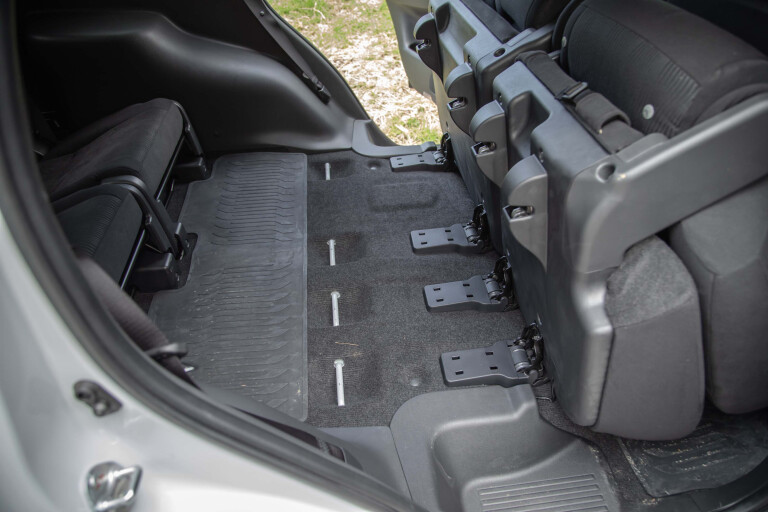
But what about the all-important folding of the third row when you want to use that space for cargo? Pulling on straps unlatches the sprung third-row bases, while another pair of straps allow the backrests to fold flat. The re-erecting process, however, is not quite as seamless.
Popping the backrests upright is no problem but you then need to lean over them to reach the folded seat bases, which requires a bit of muscle and is a reasonable stretch, potentially a challenge for shorter owners.
With all seats in use, cargo space is just 131 litres; small for the segment. Fine for groceries or school bags, less great for an airport run. With the third row folded, this bumps up to 502L, while folding the second row liberates 1488L.
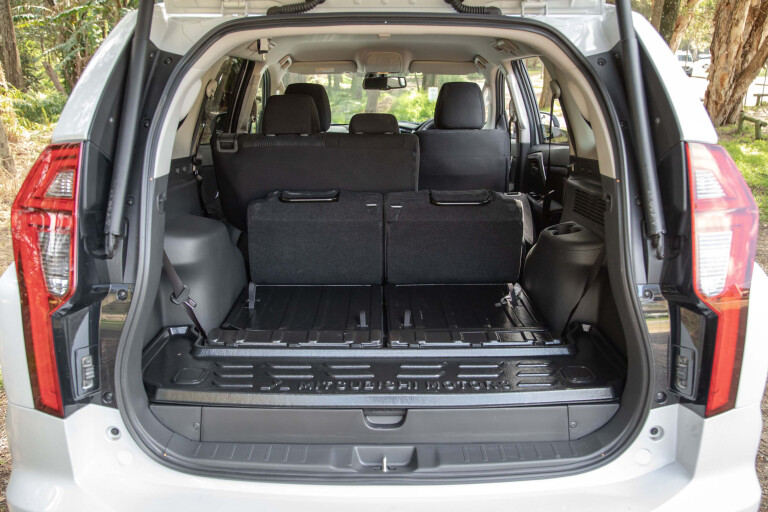
Safety
The Pajero Sport has a five-star ANCAP rating from 2015, and yes, it gets the basics right, but there are some omissions that you will find on competitors in this price bracket.
What is included are seven airbags, autonomous emergency braking (AEB), adaptive cruise control, a reversing camera, and rear parking sensors.
But no front parking sensors, which seems mean in the extreme, no blind-spot monitoring, no lane-departure warning, lane-keep assist, or rear cross-traffic alert.
For these, you need to step up to the Exceed grade.
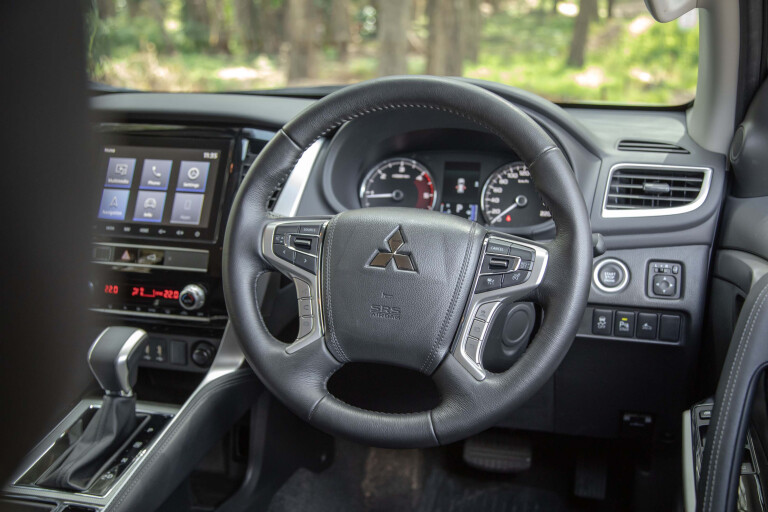
On the Road
First inescapable fact of life behind the wheel of Pajero Sport: the 2.4-litre diesel engine insists on being a vocal contributor to the driving soundtrack. This is not a quiet unit. Nor is it especially smooth, imparting a light layer of vibration through the steering wheel idle, as it does in the Triton.
It is sufficiently responsive to the throttle in the step-off phase, helped in part by sensibly short first and second ratios of the eight-speed automatic transmission, which shuffles up the gears quickly and smoothly.
Urban performance then is perfectly adequate even if acceleration numbers show the Pajero Sport is around a second slower to 100km/h from a standing start than a couple of its swifter segment competitors.
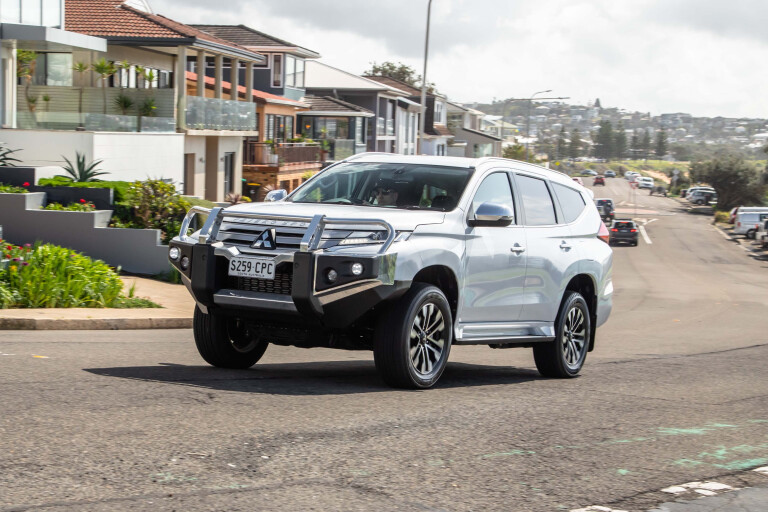
Yes, this is of questionable relevance to the target audience but it is indicative of the fact that the 133kW engine does need to be worked harder with a full complement of passengers on board in hilly terrain on the open road.
There are no paddleshifters to allow the driver to take manual control of the transmission, and granted most won’t miss this omission. If you really insist on overriding the eight-speed auto you can move the selector over into the manual gate, though its shift pattern is the reverse of what is largely accepted as the preferred layout.
It will hold a selected ratio against the engine’s limiter, although quite why you’d want to is another question altogether. Above 4000rpm, the engine is making a very vocal protestation that it’s not thrilled to be working in that zone. Like most diesels, it’s happiest in the band from just off idle to around 3500rpm, with peak torque (430Nm) produced 2500rpm.
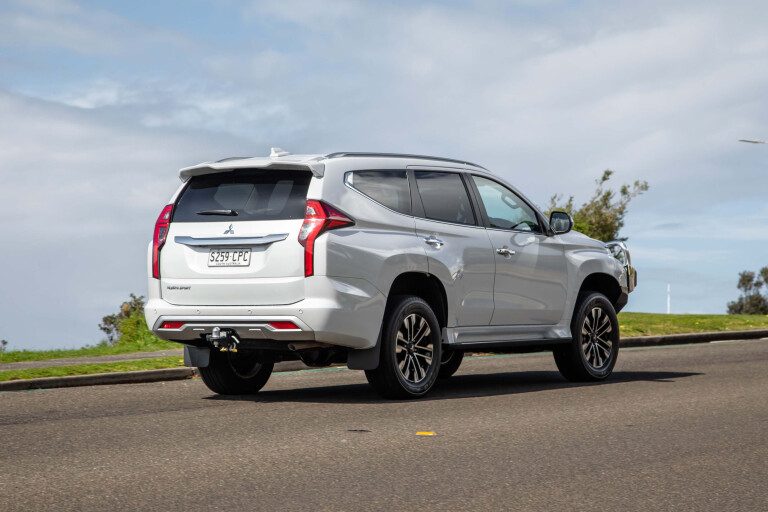
As for motorway cruising? At 110km/h in eighth gear, the engine is turning over 1900rpm so still audible, but with the addition of light wind and tyre noise, it’s no longer the dominant soundtrack.
The steering is slightly lifeless just either side of centre, which is not ideal in around-town driving but does make the Pajero Sport feel less nervous and more planted touring speeds. It’s not light, but the weighting remains consistent across the full span of 3.6 turns lock to lock.
So not a fast rack by SUV standards, but least it does have a reassuring self-centring action as you straighten up out of roundabouts or intersections, avoiding that leaden, manual unwinding of the wheel required by some competitors in the segment.
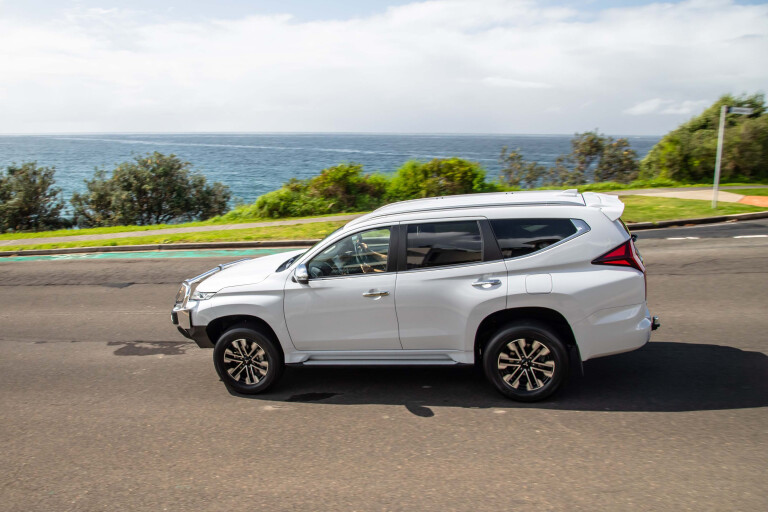
Under the Pajero Sport’s back end, the live axle is located by a three-link system with coil springs and a Panhard rod in lieu of the leaf springs under the Triton on which it’s based.
This does benefit ride comfort, but again, it’s important to make the distinction between the ride comfort of a 4x4 (sorry, 4x2) on a separate chassis and not be lulled into comparisons with unibody SUVs that have neither the ground clearance nor the towing capability of the Pajero Sport.
Fact is, a slightly lively, reactive ride is an almost inescapable reality of this vehicle design. The Pajero Sport does telegraph constant information about what’s happening road level, however, it’s rarely intrusive or properly uncomfortable. More a jiggle you learn to live with.
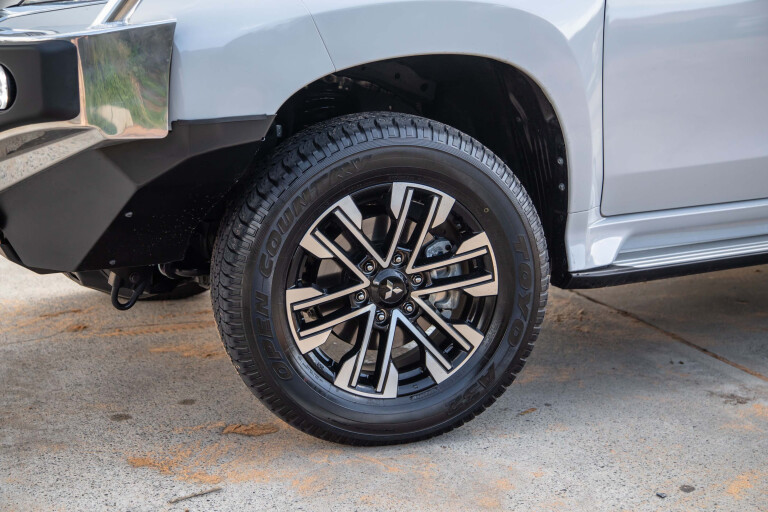
But you’d never call it quiet. The Toyo Cross Country tyres are designed to hold their own both on the bitumen and unsealed surfaces so the chunky tread pattern tends to slap audibly over expansion gaps and thrum on coarse-chip bitumen.
Backroad undulations taken 100km/h cause a bit of heave as the chassis tries to contain the mass.
On wet roads during our testing, judicious throttle applications in tight conditions did trigger some benign wheelspin, quickly snuffed out by the traction control. Not a big giảm giá, but no question that the ‘4H’ setting in the four-wheel drive version of the GLS does give a useful traction advantage on wet or greasy roads.
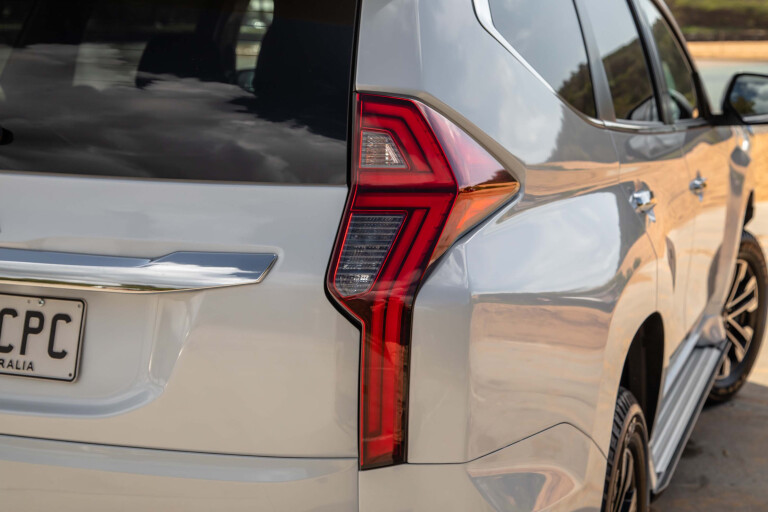
As for ability away from the bitumen? We didn’t have an opportunity for a proper off-road test, but past experience suggests that relying on drive to only the rear wheels means the real limitations come in sand, or when the terrain turns steep and/or muddy.
If you can avoid slimy 10 per cent gradients and deep soft sand, you may actually find that the Pajero Sport copes pretty admirably without four-wheel drive.
Ground clearance of 218 millimetres combined with decent approach and departure angles mean that it’s quite capable in deep ruts and washaways that would have drivers of most SUVs grounding out and potentially looking for a friendly 4x4 rescuer with a snatch strap.
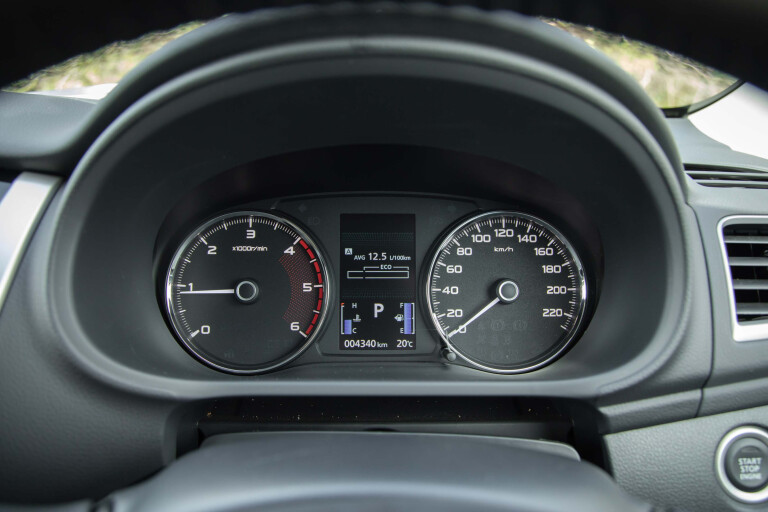
Towing
If you plan on using the GLS 4x2 as a load hauler, its listed maximum tow ball load is 300kg (10kg less than the 4x4 version) and its towing capacity is 750kg (unbraked) or 3000kg braked, which is 100kg less than the 4x4 version of the Pajero Sport.
So the Pajero Sport's max towing capacity is excellent, but not class-leading. That title is claimed by the Isuzu MU-X 4x2, which boasts a 3500kg braked towing capability.
However, it's crucial to calculate gross vehicle mass when towing a trailer that is the limit of any vehicle's braked towing capacity. In the case of the MU-X, it would be limited to a remaining vehicle payload (passengers, luggage, etc) of 315kg when towing a 3500kg trailer.
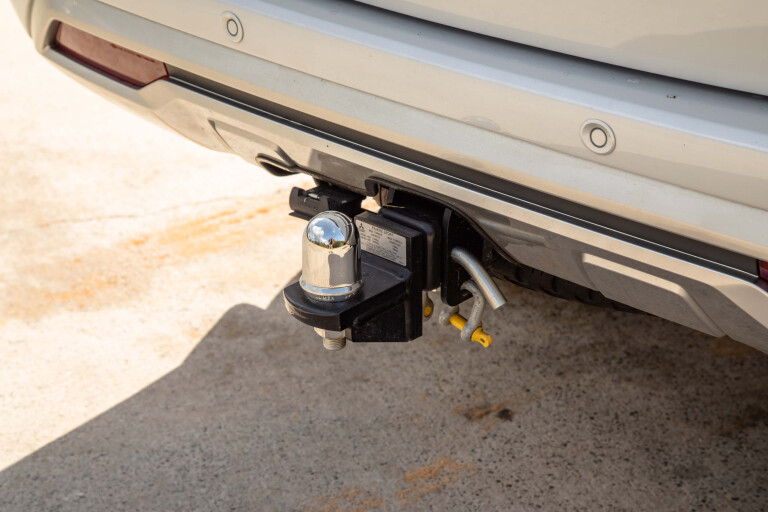
For the Pajero Sport towing its max 3000kg, vehicle payload is over 100kg greater 420kg.
Regardless, it's clear why Pajero Sport remains a popular choice for heavy hauling when comparing it to a unibody SUV. For example, Tập đoàn Mitsubishi’s Outlander SUV is rated safe to haul a little more than half that of Pajero Sport – 1600kg (braked) – while a Hyundai Santa Fe is rated 2500kg braked.
Our tip: seek out specific professional advice before hitching anything approaching these weights to any of these vehicles.
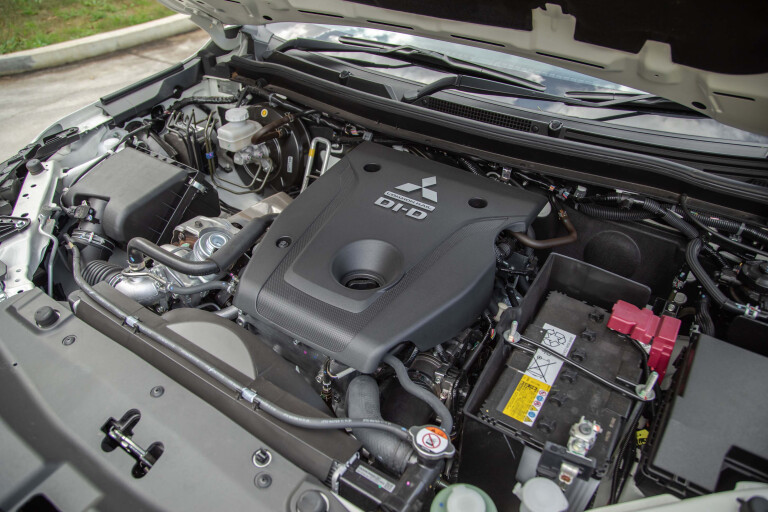
Ownership
This is an area in which Pajero Sport strengthens its case. Tập đoàn Mitsubishi’s 10-year/200,000km warranty is the industry’s best – although it is contingent on the vehicle being serviced a Mitsu dealer, otherwise, the warranty becomes five years/100,000km.
Service intervals are every 12 months or 15,000km, whichever comes first. The first five years of servicing totals $2495, which is slightly more than you’ll pay for the Isuzu MU-X ($2315) but usefully cheaper than the Toyota Fortuner, which has shorter intervals of six months or 10,000km and costs $3558 to service over five years.
The Pajero Sport doesn’t mind a drink, however. On our urban loop, including plenty of typical stop-start traffic, it consumed diesel a rate of 12.6L/100km, a fair bit up on the official urban claim of 9.8L/100km. Our second, longer, loop with more suburban and open-road driving, dropped this to 9.1L/100km, closer to the official combined claim of 8.0L/100km.
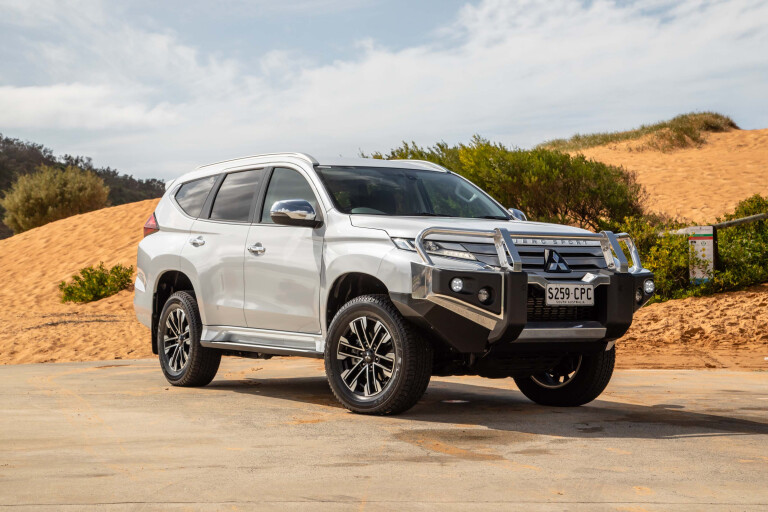
VERDICT
There’s no question that the age of Pajero Sport’s mechanicals and underpinnings put it a disadvantage compared to more modern rivals, especially in the area of noise and vibration. Likewise, its cabin feels a generation behind.
But for anyone who puts a greater emphasis on utility, simplicity and a long warranty, there’s still appeal here. The more specific issue is whether the lack of four-wheel drive in a vehicle so clearly engineered for off-road capability makes complete sense.
As we said from the outset, that’s something that can only be addressed on an individual user basis. If you need a robust seven-seater with generous ground clearance and hefty braked towing ability, put it on the shortlist that includes the Everest and MU-X, and, for value and equipment, a SsangYong Rexton.
But if your off-road requirements are for light-duty trails only and your towing life is more box trailer rather than trailer park, you’re likely better off looking Tập đoàn Mitsubishi’s Outlander, or seven-seaters from Hyundai or Kia; all of which deliver quieter, smoother, less compromised on-road performance.
2023 Tập đoàn Mitsubishi Pajero Sport GLS 4x2 specifications
Body5-door, 7-seat large SUV Driverear-wheel Engine2442cc 4-cylinder turbo diesel Transmission8-speed automatic Power133kW @ 3500rpm Torque430Nm @ 2500 Bore stroke (mm)86 x 105 Compression ratio15.5 : 1.0 0-100km/h11 seconds (estimated) Weight1980kg (kerb) SuspensionDouble A-arm, coil springs (front); live axle with three links and coil springs (rear) L/W/H4825/1815/1835mm Wheelbase2800mm Brakes315mm ventilated discs (front); 285mm solid discs (rear) Tyres265/60 R18 Toyo Cross Country Wheels18-inch alloys Price$48,690 + on-road costs
7.0
Safety, value and features
Things we like
- Value pricingConditional 10-year warrantyAffordable service schedule
Not so much
- Dull steeringEngine noiseExcessive body toàn thân lean through corners
Is Montero Sport fast?
Estimated to cross the 0-100km/h acceleration benchmark in approximately 10-seconds, the near two-tonne Montero Sport is meanwhile capable of achieving a 182km/h top speed.How many horsepower does a Montero Sport have?
The Tập đoàn Mitsubishi Montero Sport is powered by the 2.4-liter DOHC inline-4 4N15 diesel mill which features electronic common rail direct injection, a variable geometry turbo and the Japanese brand's MIVEC System, it churns out 178hp and 430Nm of torque.Is Montero good for off
Can the Tập đoàn Mitsubishi Montero go off-road? Absolutely! While we wouldn't take it rock crawling, the Montero has just the right amount of off-road oomph to get you through some pretty serious trails. Plus, as a discontinued model, you should be able to find a used Montero a very reasonable price.Does Montero Sport have Turbo?
The Drive. The new Montero Sport is tougher than ever before. It has a powerful fuel-efficient 2.4 liter turbo diesel engine and an advanced 4WD system that will take you from city streets to the far beyond. Tải thêm tài liệu liên quan đến nội dung bài viết Montero Sport 2023 specs programming 2023 2024 Montero Sport Montero Sport